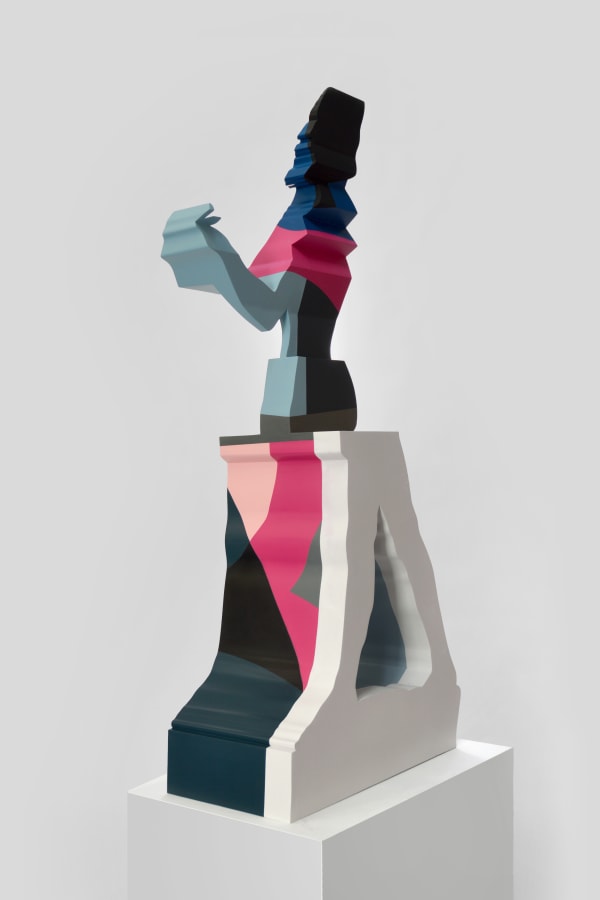Collaboration, in different forms, is integral to Hornby’s practice. As has been noted, his first major body of work, the Intersections, grew out of a genuine attempt to collaborate with a group of young people for a commission for the Southbank Centre. The result was a single object mathematically and evenly designed by six people. Hornby’s presence as an artist was in the final composite form, simultaneously demonstrating the artist’s role as producer, orchestrator, architect, curator, facilitator and collaborator.
Hornby considers his inclusion of works from art history to be an act of collaboration as much as appropriation. Collaboration is a form of dialogue – a two-way process in which the sharing of ideas creates something new that perhaps neither party would have con- ceived or produced on their own. Sculpture, as Hornby is keen to point out, is ‘inherently and historically collaborative’, the artist working closely with foundries, technicians, engineers and many other specialists in the daily production of his work.
Hornby has also actively sought out collaborations with fellow living artists. ‘If my practice conceptually engages with authorship,’ he says, ‘then co-authorship with another artist is a way to make visible that dialogue.’ The two most significant collaborations Hornby has undertaken to date have been with painter Sinta Tantra and photographer Louie Banks. In both cases the collaborators embraced the possibilities of wrapping images around objects, investigating how allusions to pictorial depth relate to objecthood.
Hornby considers his inclusion of works from art history to be an act of collaboration as much as appropriation. Collaboration is a form of dialogue – a two-way process in which the sharing of ideas creates something new that perhaps neither party would have con- ceived or produced on their own. Sculpture, as Hornby is keen to point out, is ‘inherently and historically collaborative’, the artist working closely with foundries, technicians, engineers and many other specialists in the daily production of his work.
Hornby has also actively sought out collaborations with fellow living artists. ‘If my practice conceptually engages with authorship,’ he says, ‘then co-authorship with another artist is a way to make visible that dialogue.’ The two most significant collaborations Hornby has undertaken to date have been with painter Sinta Tantra and photographer Louie Banks. In both cases the collaborators embraced the possibilities of wrapping images around objects, investigating how allusions to pictorial depth relate to objecthood.
-
 Patron i - Experiments in Colour , 2015Marble Resin, Paint60 x 30 x 30 cm
Patron i - Experiments in Colour , 2015Marble Resin, Paint60 x 30 x 30 cm
23 5/8 x 11 3/4 x 11 3/4 inUnique -
 All of Leighton in Hague Blue, Lush Pink and Cornforth, 2012Marble resin composite and paint98 x 75 x 44 cm
All of Leighton in Hague Blue, Lush Pink and Cornforth, 2012Marble resin composite and paint98 x 75 x 44 cm
Unique -
 I never wanted to lean more heavily on a man than a bird, 2015Resin, Paint110 x 57 x 18 cm
I never wanted to lean more heavily on a man than a bird, 2015Resin, Paint110 x 57 x 18 cm
43 1/4 x 22 1/2 x 7 1/8 inUnique -
 Yes, Yes, in Chinese Blue, Hague, Cornforth, Telemagenta, Railings, Lush Pink and Drawing Room, 2015Marble Resin Composite, paint200 x 100 x 46 cm
Yes, Yes, in Chinese Blue, Hague, Cornforth, Telemagenta, Railings, Lush Pink and Drawing Room, 2015Marble Resin Composite, paint200 x 100 x 46 cm
78 3/4 x 39 3/8 x 18 1/8 in -
 Muse I - Experiments in Colour #1, 2015Marble resin composite, Paint60 x 30 x 30 cm
Muse I - Experiments in Colour #1, 2015Marble resin composite, Paint60 x 30 x 30 cm
23 5/8 x 11 3/4 x 11 3/4 in -
 Patron I - Experiments in Colour, 2017Bronze, Paint100 x 60 x 60 cm
Patron I - Experiments in Colour, 2017Bronze, Paint100 x 60 x 60 cm
39 3/8 x 23 5/8 x 23 5/8 in -
 The Broken Monument in Chinese Blue, Hague Blue, Archive, Railings, Cornforth, Bubblicious and Firefly Red, 2012Marble resin composite and paint300 x 241 x 75 cm
The Broken Monument in Chinese Blue, Hague Blue, Archive, Railings, Cornforth, Bubblicious and Firefly Red, 2012Marble resin composite and paint300 x 241 x 75 cm
-
 Muse I - Experiments in Colour #1, 2015Marble resin composite, Paint60 x 30 x 30 cm
Muse I - Experiments in Colour #1, 2015Marble resin composite, Paint60 x 30 x 30 cm
23 5/8 x 11 3/4 x 11 3/4 in -
 Patron i - Experiments in Colour , 2015Marble Resin, Paint60 x 30 x 30 cm
Patron i - Experiments in Colour , 2015Marble Resin, Paint60 x 30 x 30 cm
23 5/8 x 11 3/4 x 11 3/4 inUnique -
 Yes, Yes, in Chinese Blue, Hague, Cornforth, Telemagenta, Railings, Lush Pink and Drawing Room, 2015Marble Resin Composite, paint200 x 100 x 46 cm
Yes, Yes, in Chinese Blue, Hague, Cornforth, Telemagenta, Railings, Lush Pink and Drawing Room, 2015Marble Resin Composite, paint200 x 100 x 46 cm
78 3/4 x 39 3/8 x 18 1/8 in -
 The Broken Monument in Chinese Blue, Hague Blue, Archive, Railings, Cornforth, Bubblicious and Firefly Red, 2012Marble resin composite and paint300 x 241 x 75 cm
The Broken Monument in Chinese Blue, Hague Blue, Archive, Railings, Cornforth, Bubblicious and Firefly Red, 2012Marble resin composite and paint300 x 241 x 75 cm
118 x 95 x 30 in










